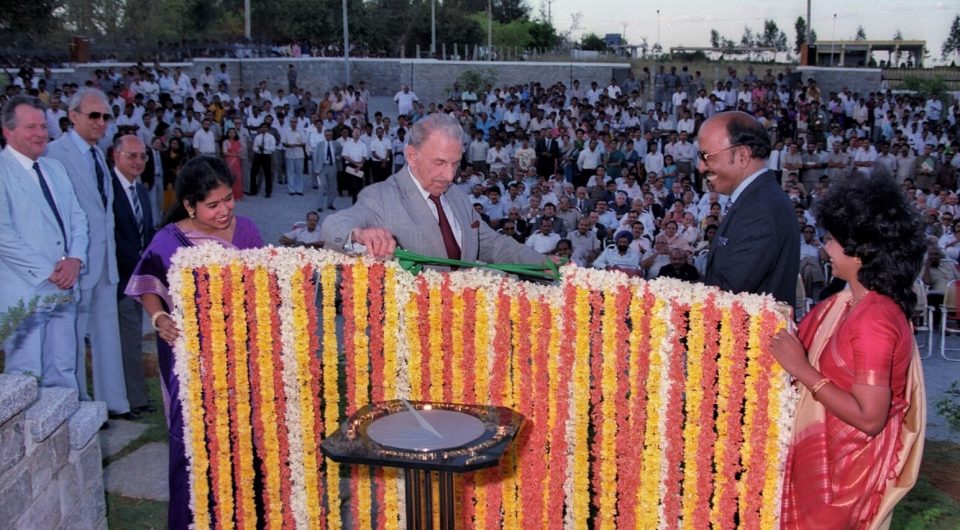
As Titan hits ₹2 trillion m-cap, tracing its journey from TN to the world

It is a tune that sends waves of nostalgia washing over those who grew up watching television in the 1990s post-economic liberalisation India. Even Gen Z – born between 1997 and 2012 – would have no trouble recognising it, so deeply has Titan’s signature tune – Mozart’s Symphony No. 25 in G minor – entrenched itself in the public consciousness.
That instant recognition partly explains why Titan Company Limited is one of the most successful – and beloved – consumer brands in India. On Thursday the company became only the second Tata group firm – after Tata Consultancy Services – to touch ₹2 trillion ($26.76 billion) market capitalisation.
A day earlier, Titan had reported a strong recovery in demand in the September quarter. The jewellery segment saw a 78 per cent year-on-year growth (excluding bullion sales). It clocked 32 per cent CAGR on a two-year basis. The segment added 13 stores in the second quarter, taking the total store count to 414.
The watches and wearables division recovered rapidly, with increased sales across all product brands. The segment reported a 73 per cent growth.
The eyewear segment was also in rude health, with revenue rising 74 per cent year-on-year. The segment’s sales were up 121 per cent.
In short, things are ticking along nicely for Titan.
The Tamil Nadu connection
The Titan Watch Project was the result of a joint venture between Tata Industries and the Tamil Nadu Industrial Development Corporation in June 1984.
Xerxes Desai was already a two-decade veteran at the group when he was appointed the first CEO of Titan. An alumnus of Oxford University, Desai set up the first Titan manufacturing unit in Hosur, Tamil Nadu, 40 kilometres southeast of Bangalore, where HMT was located. Soon the people of Hosur, who had never heard of the Tatas or even knew how battery-operated watches worked, were churning out wrist watches with features such as gold-plated dials with leather straps, steel and gold straps, and gold plated bracelets.
The brand was a hit almost from the word go. When Titan opened its first showroom, in Safina Plaza, Bangalore, on December 23, 1987, hundreds turned up with newspaper cuttings of the catalogue.
Over the next 25 years, the Titan Watch Project underwent several name changes – from Titan Watches to Titan Industries to what’s today the Titan Company Limited.
But despite the nomenclature changes, the company has continued to produce more than 15 million watches every year and invest in new technologies and innovations.
In 1993 it entered the European market, followed by the Middle East and Asia Pacific, selling more than 150 million pieces across 32 countries.

Timex Group India was incorporated in 1988 as a joint venture between Timex Corporation USA and Titan. The JV lasted until 1998, claiming second position after Titan. Titan, after the dissolution of the partnership, reclaimed the market share with Sonata. This was followed by an array of wrist wear watches and luxury pieces.
During this period Titan also teamed up with world renowned architect Charles Correa to create a school and learning facility for more than 2,000 Titanians in Mathigiri district, next to Hosur.
The expansion
In 1994 Titan launched the luxury jewellery brand Tanishq. Today Tanishq is the largest branded jewellery maker in India, with more than 80 per cent of its total revenues coming from the jewellery segment.
This diversification was followed by more ventures: Fastrack, a youth brand; Precision Engineering; and the Titan Eyewear Division, complete with specialised outlets.
In 2011, Titan launched Mia, a 14-karat gold jewellery range for working women. 2013 saw the company penetrate the perfume market with SKINN. In 2016, Tanishq took over Carat Lane, a physical and online jewellery retailer headquartered in Chennai. Exactly five years since it acquired the Swiss watch brand Favre-Leuba in 2011, Titan relaunched the iconic watch brand in 2016, which was a household name in India in the 1960s and 1970s.

